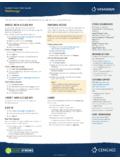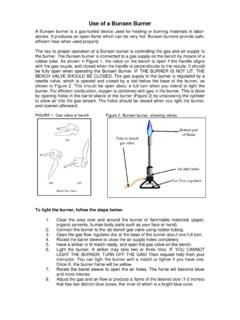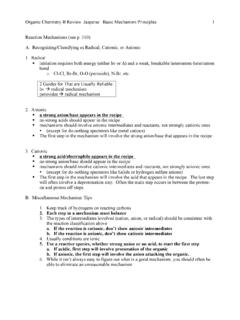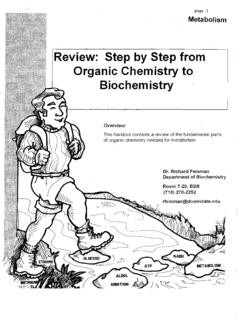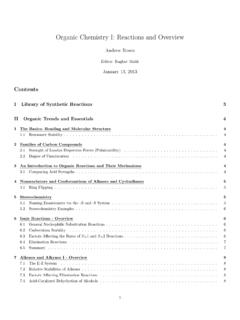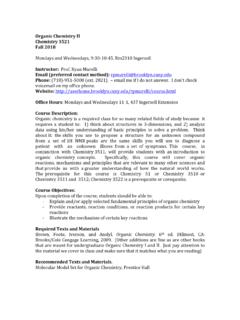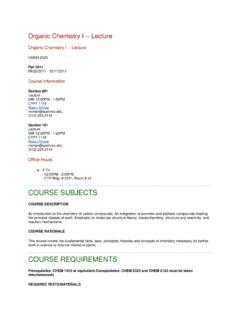Transcription of Chapter 13 { Organic Chemistry - WebAssign
1 Chapter 13 Organic ChemistryIntroductionOrganic Chemistry is the study of carbon based compounds. The structural and genetic materials of livingorganisms are Organic compounds. Many of the substances that we encounter on a daily basis are Organic compounds:drugs, plastics, textiles, dyes, paper, food, vitamins, etc. Because of the manner in which carbon atoms can bond toone another, the number of Organic compounds is enormous. In this Chapter , we explore some of the fundamentaltopics of the structure and reactivity of several classes of Organic compounds by applying our knowledge of Lewisstructures, resonance, and Lewis acid-base HydrocarbonsIntroductionWe begin our study of Organic Chemistry with two classes of compounds that contain only carbon and Formal Charge and Oxidation State (Draw Lewis structures.)
2 Objectives Name and draw the two simplest alkanes. Draw line-wedge-dash, Lewis, condensed, and skeletal structures of alkanes. Convert skeletal structures into molecular formulas. Distinguish between a straight or continuous chain and a branched chain. Write the equation for the combustion of an alkane. Define an alkene and draw and name the two simplest alkenes. Draw the isomers of an alkene. Define a polyene and explain why many polyenes absorb visible light. Define alkynes and discuss their isomers. Distinguish between saturated and unsaturated DefinitionCarbon atoms always have four bonds: four single bonds, two single and one double bond, two double bonds,or a single bond and a triple bond.
3 Although carbon is the basic building block, Organic compounds usually havehydrogen atoms as well. Oxygen and nitrogen are also common, but almost any other element can be found in organiccompounds. In this section, we deal with the class of compounds known ashydrocarbons, which are compoundsthat contain only carbon and the simplest Organic compounds. All of the carbon atoms in an alkane are sp3hybridized andtetrahedral, and all bonds are sigma bonds, which makes alkanes relatively unreactive. They have the generalformula CnH2n+ 2, wherenis an integer.
4 Table shows the three simplest , CH4 Ethane, C2H6 Propane, C3H8 Table : The Simplest StructuresCarbon atoms always have four bonds in their are times when the line-wedge-dash representation is used to show the three-dimensional structure oforganic compounds, but the structures of alkanes are very dynamic becausegroups attached by a single bondcan rotate relative to one another (much like the wheels on an axle). Consequently, other shorthandnotations are frequently used. These other methods, shown in Figures , , , and , are based onthe following points that are common to most Organic molecules.
5 Carbon atoms form their backbone. Carbon atoms always have four bonds to them. There are usually many C H bonds : Representations of Propane: Wedge-DashPropane is C3H8. Figure shows the line-wedge-dash representation of the three-dimensional : Representations of Propane: Lewis StructureIn aLewis structureof an Organic compound, all of the bonds and atoms are shown explicitly, but the bondangles are often shown as 90 .Figure : Representations of Propane: Condensed Structure2c 2014 Advanced Instructional Systems, Inc. and NC State College of Sciences FoundationAcondensed structureshows the atoms, but not all of the bonds.
6 Sometimes the C C bonds are shown, butfrequently they are : Representations of Propane: Skeletal StructureAskeletal structuredoes not show carbon or hydrogen atoms explicitly, nor does it show the C H bonds. Thepositions of the carbon atoms in a skeletal structure are indicated by the ends and intersections of lines. Thus, thestructure of propane shows three carbon atoms: one at each end and one at the intersection of the two line positions of the hydrogen atoms are inferred from the number of bonds shown to each carbon. Each carbonatom must have four bonds (a double bond counts as two bonds and a triple bond counts as three), sothe numberof C H bonds to any carbon atom equals four minus the number of bonds shown to the carbon atomin the skeletal structure.
7 For example, the skeletal structure shows only one bond to each of the terminal carbonatoms, so there must also be three C H bonds to each of the end carbons. The structure shows two bonds to themiddle carbon, so there must also be two C H Molecular Formulas for Skeletal StructuresNeither carbon nor hydrogen atoms are shown explicitly in a skeletal the following rules to convert the skeletal structures into molecular formulas. Carbon atoms are represented as intersections or ends of lines. The number of hydrogen atoms attached to a carbon atom is equal to four minus the number of bondsinvolving the carbon atom because carbon atoms are always involved in four bonds.
8 Note that double andtriple bonds count as 2 and 3 bonds, :Write the molecular formula for the given skeletal that the order of elements in theformula should be C then H then ChainsIsomers are different molecules with the same is only one way to connect the carbon atoms in each of the alkanes discussed so far, but there are multipleways to connect the carbon atoms in all of the alkanes with more than three carbon atoms. The way in whichthe carbon atoms are connected is called theconnectivity. The molecules with the same formula but differentconnectivities are different molecules, and different molecules with the same formula are 2014 Advanced Instructional Systems, Inc.
9 And NC State College of Sciences Foundation3 Molecules in which no carbon is connected to more than two other carbons are calledstraight chainsorcontinuous chains, while molecules that contain with at least one carbon with three or four carbon atoms attachedto it are calledbranched chains. Butane (C4H10) exists as two isomers, one straight chain and one branched : Isomers of Butane: Straight ChainLewis (a), condensed (b), and skeletal (c)representations of the straight or continuous chain isomer: It is a straight chain isomer because none of thecarbon atoms are connected to more than two other carbon : Isomers of Butane.
10 Branched ChainIt is a branched isomer because there arethree carbon atoms connected to the central carbon atom, so the chain branches at that CombustionAlkanes are found primarily in natural gas (mainly CH4and C2H6) and petroleum. They are relatively unreactive,but they do burn well. Burning is a rapid combustion, , the reaction with oxygen. The products of the combustionof an alkane are CO2and H2O. Table shows the heats of combustion for four common ReactionHeat of Combustion(kJ/mol)methanenatural gas furnaceCH4+ 2 O2 CO2+ 2 H2O 891propanepropane tankC3H8+ 5 O2 3 CO2+ 4 H2O 2220butanecigarette lightersC4H10+ O2 4 CO2+ 5 H2O 2855octaneautomobile fuelC8H18+ O2 8 CO2+ 9 H2O 5494 Table : Combustion of Some Common Octane RatingsEach atom in a C H or C C bond retains one of the bonding electrons during combustion.




